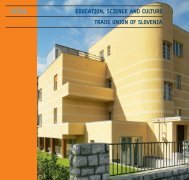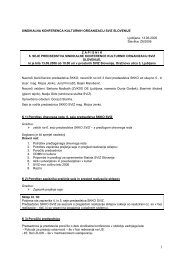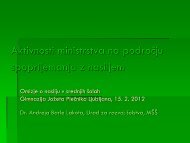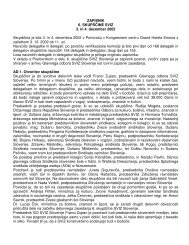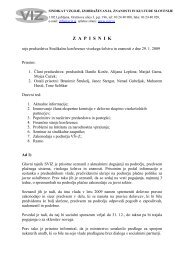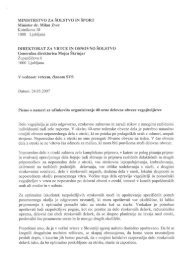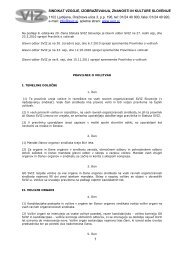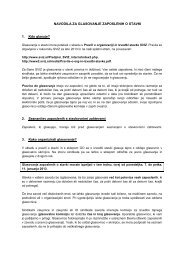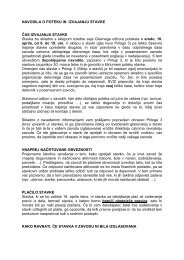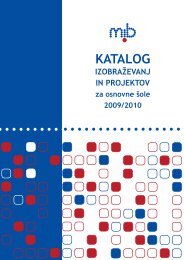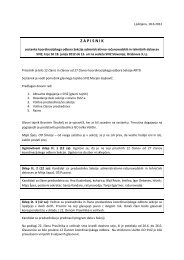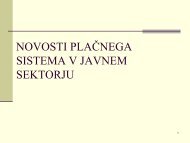Create successful ePaper yourself
Turn your PDF publications into a flip-book with our unique Google optimized e-Paper software.
azgibana koda, ki nato resignira v pianissimo. V sledečem Allegrettu<br />
prva tema sestoji iz dveh kontrastnih elementov, ki sooblikujeta potek<br />
stavka: postopa violončela navzgor ter kantilene violine. Kromatična<br />
druga tema pripelje v fugatni odsek. Posamezni motivi se po izpeljavi<br />
vse bolj drobijo, dokler nazadnje ne ostanejo le še skupinice »vzdihov«.<br />
V eksplozivnem Scherzu Beethoven uporabi nenavadne kontraste med<br />
tonalitetami. Zadnji stavek uvaja otožen uvod z motivi vzdihov, ki jim<br />
sledi napet in ambivalenten zaključek: »allegretto« je nežnejši tempo,<br />
kakršnega »agitato« spodbija. Sklep kvarteta, čeprav v duru, se tako zdi<br />
bolj uporniško dejanje volje kot sprava s svetom in seboj.<br />
After studying the viola in Brisbane and Berlin, Australian composer, violist<br />
and conductor Brett Dean joined the Berlin Philharmonic in 1985. In 2000, he<br />
returned to Australia and dedicated himself to composing. His first works were<br />
linked with experimental films. From the first public performance of his work<br />
some birthday … in 1992, Dean spent more and more time composing, and<br />
his works are performed by recognised orchestras and conductors throughout<br />
the world. In 2006, he became the artistic director of the Australian National<br />
Academy of Music. For his violin concerto The Lost Art of Letter Writing he<br />
received the prestigious Grawemeyer Award 2009, which is virtually regarded<br />
as the ‘Nobel Prize for music’.<br />
Dean regards himself as a traditionalist, and in his compositions one can<br />
recognise the influence of film, electronic music, and painting. He applies<br />
layers of sound to his ‘canvas’ like a painter. His composition Carlo is also a<br />
‘painterly’ work. It was commissioned by the Australian Chamber Orchestra<br />
for the Huntington Festival in 1997. The title refers to Carlo Gesualdo, who was<br />
a highly regarded composer of vocal music, while at the same time being one<br />
of the most notorious criminals of 16 th century Italy – in 1590 he murdered<br />
his wife and her lover. Deans seeks links between Gesualdo’s life and music:<br />
the texts of Gesualdo’s later madrigals are full of associations with love,<br />
guilt and death. Carlo begins with a recording of Gesualdo’s madrigal Moro<br />
lasso. Alongside a collage of musical quotations from the madrigal, which<br />
are harmonically connected but diverse in terms of character, the orchestra<br />
of solo strings is included in the process with quotations from other works<br />
by Gesualdo, drawing the music ever closer to the sound world of the 20 th<br />
century. Carlo is a journey between two eras, two types of music. Eventually<br />
Gesualdo’s madrigals withdraw into whispering and nervous sighing, echoes<br />
of that fateful Neapolitan night in 1590.<br />
PROGRAM / PROGRAM<br />
In the second half of the 18 th century, an enormous influence was exerted on<br />
European music by “a boring chap who composed again and again in one and<br />
the same form”, as he was described by Stravinsky. However, in spite of the<br />
incredible number of concertos he produced (around 500 in total) Antonio<br />
Vivaldi was far from being boring. He was one of the most original Italian<br />
composers of his generation, an imaginative and extravagant individualist,<br />
but at the same time a pious and earnest man. His concerto opus reveals<br />
69



